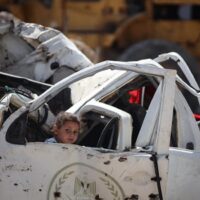HARARE: Some time ago, the head of the United Nations refugee agency, Antonio Guterres, said of the Democratic Republic of Congo: “Nobody in the outside world feels threatened, and so the international community is not really paying attention.
Not anymore: currently, Congo’s eastern province of North Kivu is in the headlines almost every day. Last August, fighting to the north of the provincial capital Goma flared up again, provoking a major humanitarian crisis that has no end in sight.
Like the eight-year civil war (in what was then known as Zaire) that nominally ended in 2002, the current fighting involves many different local groups: not only the Congolese government forces, which oppose the insurgents loyal to the Tutsi General Laurent Nkunda, but also the Rwandan Hutu rebels who were responsible for the genocide in Rwanda in the 1990’s and a jungle force known as the “Mai-Mai militias. “It is a basket of crabs, one Congolese friend told me.
As always, the main victims are civilians caught in the crossfire. The renewed fighting, coming eight months after a promising peace initiative known as the “Goma Agreement, means more civilian deaths and little chance of normality returning to the eastern part of Congo.
Yet, even at times when fighting is less intense Congo suffers from the indirect effects of the war. A mortality survey conducted by the International Rescue Committee (IRC) and released earlier this year demonstrates that this conflict is the world’s most deadly crisis since World War II: an estimated 5.4 million people have died as a consequence of the war and its lingering effects in the last decade. Today, a quarter of a million people are on the run, almost half of them on territory under rebel control and with almost no access to aid. They need food and shelter, clean water and latrines, medical care, and education. Women and girls need protection from sexual violence, which flares up when families are forcibly displaced.
It may sound strange, but from the point of view of a humanitarian relief agency, it is not important on whose territory civilians in need are, as long as there is access to them. Aid workers who have been in the country for a dozen years, especially from groups like my own IRC, must work with all parties to the conflict because civilians in need are everywhere. But aid agencies need access.
The UN peacekeeping force in Congo, MONUC, has a mandate from the Security Council for full intervention in order to provide protection to the civilian population. So when aid workers are stopped at gunpoint and cannot talk their way through, humanitarian agencies naturally turn to MONUC to guarantee access.
Humanitarian workers are not military strategists, so they cannot judge what kind and what size of deployment of peacekeepers is adequate. But the aid agencies that work on the ground have first-hand experience of the impact of peacekeepers’ presence, and we have the authority to say that protection of aid workers can be dangerously inadequate.
Indeed, at the height of the fighting for control of the northern town of Rutshuru last October, the IRC teams that were stationed there decided to evacuate temporarily because the risk was simply too great. Together with other aid agencies, IRC staff formed a convoy and MONUC offered armed vehicles to protect it. But when armed men stopped the convoy on the road, the Uruguayan peacekeepers from MONUC simply turned around and vanished, leaving the aid workers to their fate.
What followed were many hours of harassment, humiliation, threats with live hand grenades, shots fired at the feet of one of our colleagues, and looting and ransacking of the IRC premises. Finally, another group of MONUC peacekeepers – this time from India – came to the rescue and helped evacuate the aid workers on helicopters.
Protecting the humanitarian effort now underway is essential to the sheer physical survival of the Congolese displaced in North Kivu, but the only lasting solution is a ceasefire followed by a peace treaty, possibly along the lines of the “Goma agreement.
Paradoxically, the current fighting and the masses of displaced persons that it produced have helped to draw attention to the crisis. This moment must be seized not only to beef up MONUC, but, more importantly, to use all existing leverage with the combatants and the governments that back them to get all the parties to return to the negotiating table. The televised tragedy, and the shortcomings that can be observed close up, can and must be stopped, lest – as often happens with Congo – the crisis disappears from the front pages, while the killing continues unseen.
Anna Husarskais Senior Policy Adviser at the International Rescue Committee. This commentary is published by DAILY NEWS EGYPT in collaboration with Project Syndicate (www.project-syndicate.org).



